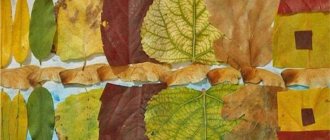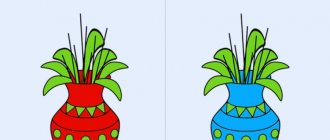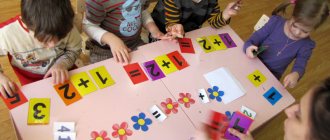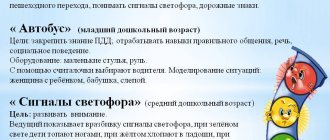Card index of didactic games for children 3-4 years old “Autumn Leaves”
DIDACTICAL GAMES “AUTUMN LEAVES”.
GAMES FOR CHILDREN 3–4 YEARS OLD.
Didactic tasks:
Learn to assemble a whole from parts; consolidate knowledge about color, size; develop visual perception, thinking, attention, logic; develop fine motor skills of the hands; develop speech.
Material
: from colored cardboard (green, yellow, red, orange), cut out maple leaves, size (large - small, in pairs. Cut each leaf in half, leave one pair uncut for the sample.
Option 1. “Collect leaves”
Goal: to develop children's constructive skills, visual attention; develop thinking, attention, creative imagination.
Progress of the game:
The adult invites the child to assemble the leaves from the parts, noting that the leaves are of different colors and sizes.
“A strong wind blew and the leaves flew away. Let's collect them."
Together with your child, fold the halves of the leaves to make whole ones.
Option 2. “Who has this piece of paper? »
Purpose: to distinguish children's constructive skills, visual attention; consolidate knowledge of colors (red, yellow, green, orange, sizes (large, small); develop speech, enrich vocabulary.
Progress of the game:
The adult gives the children one half of the cut pictures each, and keeps the remaining parts for themselves. He asks who should be given each of the halves in order to put together the whole pictures. When children choose their halves of autumn leaves, taking into account color and size, each child adds up the whole image and tells what kind of leaf he got (big red, small green, etc.)
The following options for playing with collected leaves.
Option 3. “Pick up the leaves”
Material: the same as in the previous game. Trees cut out of cardboard in yellow, red, orange, and green are added.
Goal: to teach children to distinguish colors (yellow, red, orange, green); teach to match leaves by color.
Progress of the game: Invite the child to place the leaves on the trees of the corresponding color so that the leaves are the same color as the tree.
Option 4. “Big and small leaves”
Goal: to teach children to distinguish leaves by size, to consolidate the concepts: big - small.
Progress of the game:
The adult places two pieces of paper (samples) on the table and invites the child to put large pieces of paper near the large piece of paper, and small pieces of paper near the small piece of paper.
Option 5. “Show me a piece of paper”
Goal: to teach children to show leaves according to the word denoting color. Strengthen children's ability to distinguish and name colors (green, yellow, red, orange).
Progress of the game:
The adult invites the child to show yellow leaves, red, green, orange.
Option 6. “Show me a piece of paper”
Goal: to teach children to show leaves by word indicating color and size. Strengthen children's ability to distinguish and name colors; consolidate the concepts of “big” and “small”.
Progress of the game:
The adult asks the child to find a piece of paper with a certain color and size.
- “Show me the big red leaf.”
- “Show me the little green leaf,” etc.
Option 7. “Name the leaf”
Goal: to teach children to name the color and size of a leaf. Strengthen children’s ability to distinguish and name colors (green, yellow, red, orange) and sizes (big and small, develop speech.
Progress of the game:
The adult points to the piece of paper, and the child names what color and size.
Option 8. “Find a pair.”
Goal: the ability to select pairs based on similar sensory attributes of color or size; develop visual perception.
Progress of the game:
An adult invites the children to look at the leaves and asks them to name the color. Then he invites the children to pick up pairs of colored leaves. Complication: take from 4 to 8 leaves.
Option 9. “Find the extra leaf
»
Goal: to develop children's visual attention and thinking, logic.
Progress of the game:
The adult invites the child to choose an extra leaf. In front of the child, leaves are laid out, united by some characteristic, for example, by size or color; one of them does not have such a characteristic and is superfluous.
Option 10. “What has changed? »
Goal: development of visual perception, memory, speech, enrichment of vocabulary.
Progress of the game:
An adult lays out several pieces of paper on the table.
The child is asked to close his eyes. An adult removes or swaps the leaves.
- "What changed? "
Invite your child to talk about the changes.
Option 11. Outdoor game “1, 2, 3, collect a piece of paper!” »
Goal: to develop children's constructive skills, visual attention; develop thinking, consolidate knowledge about color and size, develop auditory and visual perception.
Progress of the game:
An adult gives children one half of the cut pictures. Children walk around the playground. At a signal, they scatter and run in any direction. At the signal “collect 1, 2, 3 leaves” they stand in pairs. (Music accompaniment is used).
Complication: change the pair each time.
Outdoor games with autumn leaves
MBDOU d/s No. 3 “Alyonushka”
OUTDOOR "AUTUMN" GAMES
(middle group “Little Bunnies”)
Prepared and carried out
teacher Zhdanova I.V.
Very soon the earth will be covered with a motley and bright carpet of autumn leaves! Golden autumn will come, and with it will come the opportunity to play with “toys” provided to children by nature itself! Children like pine cones, colorful leaves and fruits of trees not only because they lie under their feet in the fall, but also because of their simplicity and laconism, they are pleasant to the touch and delight the eye with their brightness.
Our tips will tell you how to help your child find not only a pleasant, but also a useful activity outside in the fall:
Outdoor game “Wind and Leaves”.
At the signal “Wind!” - children run around the playground in different directions, waving leaves (“the wind swirls autumn leaves in the air”). At the signal “No wind!” - squat (“the leaves fell to the ground”) (1.5-2 minutes). Run without bumping into each other, give way to each other; act on a signal.
Outdoor game “Autumn Bouquet”
Objectives: improve the ability to differentiate leaves of different trees, develop observation and attention. How to play: children stand in a circle, with leaves in the center. Children move in a circle to the music. The music stops, each child chooses a piece of paper. Children make an autumn bouquet with leaves from the same tree, saying which tree the leaves come from. Next, the children put the leaves in a circle and the game begins again.
Outdoor game “Find a pair”
Objectives: learn to make pairs of leaves according to one characteristic indicated by an adult, consolidate knowledge about shape, color and size, develop auditory and visual perception. Progress of the game: children stand in a circle, in the center there are leaves (their number is according to the number of children and the leaves are selected so that pairs of leaves can be made). Children walk in a circle saying: “One, two, three - quickly take the sheet!” "Everyone takes a piece of paper. The adult says: “Find yourself a mate - a leaf of the same color. "(Other tasks: make a pair of leaves from one tree, or leaves that differ in Size: large and small, or leaves of the same size from one tree.) Note: for this game you need to prepare additional leaves from double-sided colored paper of a smaller size compared to the ones the children painted.
Outdoor game “Listen carefully”
Objectives: develop the ability to follow verbal instructions, act on a signal from an adult, consolidate knowledge about the shape of leaves of different trees. Attributes: autumn leaves of three types of trees. The number of leaves of each tree is equal to the number of players. How to play: leaves in the center of the circle. Children lead a round dance with the words: “One, two, three, quickly take the leaf!” "An adult names a tree, and the children take the leaves of only this tree and lift them up
Outdoor game "Falling Leaves"
Objectives: consolidate knowledge about the color and size of autumn leaves; learn to move around the site, following the instructions given in a playful way; to specify the concept of “leaf fall”. Material: autumn leaves. Progress of the game AN ADULT says: “Guys! You will all be leaves, choose the leaf you like: some are yellow, some are red, some are big, some are small.” Each child shows and names which leaf he chose by color and size. The teacher says: “The leaves are light, they fly slowly through the air. (Children run and wave their arms.) Leaf fall! Leaf fall! Yellow leaves are flying! Beautiful yellow leaves are spinning. (Actions are performed by children with yellow pieces of paper). Beautiful red leaves are spinning. (Actions are performed by children with red pieces of paper). They circled and sat down on the ground. (Children squat). Sit down! They sat down and froze. (The children do not move.) A light breeze came and blew. (An adult blows, followed by children) The teacher continues: “The leaves rose and scattered in different directions. (Children scatter around the playground). Spinning, spinning, spinning!
Leaf fall! Leaf fall!
Leaves are flying in the wind! The breeze has died down, and again the leaves slowly fall to the ground.” At the request of the children, the game continues 2-3 times. Outdoor game “But the rain won’t wet us” First, a small number of children participate in the game, then 10-12 people can be involved. Instead of chair houses, you can use a large colorful umbrella, under which children hide at the signal “Rain!” During the walk, you can invite children to pick flowers, berries, jump, and walk in pairs. When repeated, the game can be complicated by placing houses (3-4 chairs each) in different places in the room. Children must remember their house and run to it when given a signal.
Outdoor game “Catch a leaf”
The goal is to develop the ability to jump in place as high as possible. Progress of the game: Children try to catch a leaf hanging on a branch or flying through the air.
Outdoor game "Falling Leaves"
The goal is to consolidate children’s knowledge about the color and size of autumn leaves. Reinforce the concept of “leaf fall.” All children are given leaves from an autumn bouquet. Adult: A light autumn breeze is blowing: “U-oo-oo-oo-oo-oo-oo” (quietly). The leaves barely move. A strong wind blew: “Uuuuuuuuuuuuuuuuuuuuuuuuu!” (loud). We got lost in the forest, we shouted: “AU!” (First loudly, then quietly). Autumn leaves sit on branches, autumn leaves say to us: “A-o-i-u.” (They spin around with leaves in their hands to the music.) The wind blew and the leaves began to fall off. Leaf fall, leaf fall, yellow leaves are flying. (Children who have yellow leaves throw them on the mat and squat). Leaf fall, leaf fall, red leaves are flying. (Children with red leaves throw them on the mat and squat).
"Autumn Leaves"
Equipment: autumn leaves. Goal: To encourage children to start moving and change it at the teacher’s signal, to find their place, to teach them to coordinate their movements with the spoken words; develop dexterity and coordination of movements; help strengthen the muscular corset of the spine. Progress: An adult draws the children’s attention to a bouquet of autumn leaves. He says: “Guys, look how beautiful the autumn leaves are: red, yellow, green. There are big leaves and small ones. That's how many leaves there are in the vase. Do you want to play with them? Take a piece of paper in each hand.” Children take two pieces of paper and, as shown, perform simple movements in accordance with the text of the poem they recite: The wind blows, blows, blows, blows. Swing left and right, arms in front of you.
Yellow leaves are blowing away from the tree!
They wave their arms from top to bottom in front of them.
And the leaves fly right along the path,
spinning in place.
Leaves are falling right under our feet!
They stop, squat down, hands down.
Then the teacher says the words: The wind is blowing - we will fly where we want. The children get up and the game is repeated again. Then the leaves are collected into a common bouquet and placed in a vase.
Outdoor game “Migration of birds”.
The children stand scattered at one end of the playground. They are birds. At the other end of the site there is a gymnastic wall or tower. At the teacher’s signal, “The birds are flying away!” children, raising their arms (wings) to the sides, run around the entire playground. At the signal “Storm!” children run to the gymnastic wall (tower) and climb onto it (“birds are hiding from the storm in the trees”). When the teacher says “The storm has stopped,” the children descend from the tower and run again (“the birds continue to fly”). During the game, the teacher should be near the climbing aids in order to help the children if necessary. (The game is repeated 3-4 times.) Rules of the game: Act only on a signal, climb onto the “tree” ladder in such a way that there is enough space for all players, do not jump off the ladder, but climb down.
Thematic activity: Autumn leaves 3
Continuing the theme of autumn leaves, I decided to improve the set of tasks on this topic. The result is a new thematic set “Autumn Leaves 3” for the development of logic, fine motor skills, the ability to write, read and count, as well as draw and much more! This is a completely ready-made material for conducting a lesson on this topic with methodological recommendations for each type of task. I bring to your attention tasks for children from 1.5 to 6 years old on the topic “Autumn Leaves.”
I brought together not only those tasks that were previously, but also added a large amount of new material. The result is 55 types of tasks – that’s 60 pages! She also wrote down methodological recommendations for them. The assignments will be enough not only for several classes, but for several years, if you choose assignments that suit your children’s abilities.
Types of tasks for a thematic lesson:
- Lay out the letter L and leaves with pebbles
- Quantity cards for games with clothespins
- Memory cards for the development of logic and memory
- Cards for playing with clothespins - find the same one
- Fold the halves of the “Leaves”
- Complete the Leaves puzzles
- Maze “Autumn Leaves”
- Trace according to the pattern given at the beginning of the page.
- Sort planets by size and type
- Puzzles with numbers from 1 to 5, from 1 to 10, from 11 to 20, from 2 to 20
- Leaf structure
- Lay out the words - the names of the leaves
- Continue logical series
- Spend it for the kids
- Wires - for teaching writing
- Draw the path of falling leaves
- Connect in order from 1 to 10 and from 11 to 20, from 2 to 20
- Color the leaves in the indicated colors
- Walk your finger along the leaf
- Trace along the outline
- Trace the half and color it
- Connectors
- Find the superfluous - develop logic
- Find and count
- Walk the lines
- Connect by numbers
- Draw a leaf according to the cells
- Find five differences
- Shade the leaf
- Maze “Find the leaves”
- Alphabet maze
- Find and circle all the letters L
- Learning to write letters
- I'm learning to write words
- Fold the halves with geometric shapes
- Lay out a piece of paper - math puzzle
- Write the numbers from 1 to 20
- Send the rocket flying - write the numbers from 10 to 0
- Count the examples
- Count and color
- Cut out the path of the leaf
- Cut along the contour
- Lacing Leaves
- Breathing trainer
- Blanks for stained glass
- Creative tasks
- Game with the Autumn Leaves cube
- Game "Cubes - autumn trees"
- Description of the leaflet according to the plan
- Counting book
- Physical exercise “We are autumn leaves”
- Finger game
- Pure talk
- Riddles about autumn leaves
- Recommendations for shared and personal reading
PS This article is copyrighted and is entirely intended exclusively for private use; publication and use of it on other sites or forums is possible only with my written consent. Use for commercial purposes is strictly prohibited. All rights reserved. Author: Leonova Evgenia.
You might be interested in:
Lacing maple leaf
Thematic lesson: The fourth day of creation
Autumn letters and numbers
"Autumn"
The sun is already barely warm; (we spread our fingers on both hands and connect
palms together, then join fingers)
Migratory birds have flown south; (we wave our arms like wings)
The trees are bare, the fields are deserted, (we raise our hands)
The first snow covered the ground. (smoothly lower the handles down)
The river is covered with ice in November - (we squeeze our hands into a lock)
It's late autumn in the yard. (we spread our hands in front of us)
"Autumn".
The north wind blew: “S-s-s-s” (blowing)
I blew all the leaves off the branches... (move your fingers and blow on them)
They flew, spun and sank to the ground (wave their arms in the air)
The rain began to patter on them
Drip-drip-drip, drip-drip-drip! (tap the fingers of your right hand on the palm of your left hand)
The hail pounded on them, (with a pinch of your right hand, tap on your left palm)
It pierced all the leaves. (knock the fist of your right hand on your left palm)
The snow then powdered (smooth movements of the hands back and forth)
He covered them with a blanket. (place your right palm on your left)







